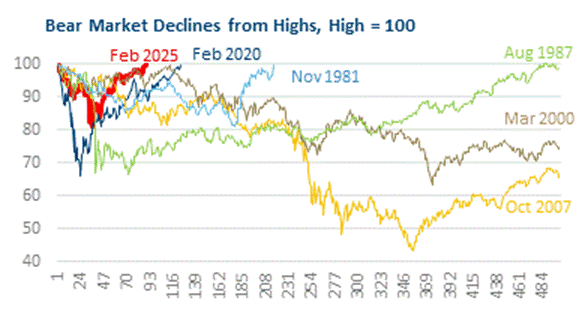The first few weeks of Q2 experienced significant market volatility in response to the proposed “Liberation Day” reciprocal tariffs. Fortunately, the strong stock market reaction (and bond market reaction) sent a signal to policymakers. As a result, on April 9, most of the tariffs were delayed 90 days to July 9. Then, on May 12, the U.S. and China, whose 100%+ tariffs on each other were rapidly choking off trade between the two countries, reached a tariff truce. Reflecting the rapid onset and rapid exit of tariff risks was the fastest high, to bear market, and back to the high cycle in history.
This is shown in Chart 1 (below), where the Feb. ’25 cycle is compared to the other bear market declines of the past fifty years, including the 1981 “Volcker” decline, the Black Monday 1987 crash, the dotcom bubble in 2000, the global financial crisis in 2007-2009 and, most recently, the 2020 Covid decline.

Chart 1
The 2025 decline is even faster than the Feb. ’20 Covid cycle, the prior record holder. Technically speaking, the 2025 decline did not reach a closing bear market, as its maximum drawdown was 19% on April 8, though did meet that level on its intraday low on April 4. Technicalities aside, the speed of the onset, and recovery, was notable. From its Feb. 19 peak, the S&P dropped 19% to its closing low on April 8, with the 12% drop from April 3 to 8 accounting for 60% of the overall decline. The subsequent recovery was equally fast and concentrated, with just two days (April 9’s 10% S&P jump on the 90-day pause and May 12’s 3% rise on the China truce) accounting for 56% of the subsequent recovery to June 27’s new high (conveniently for writers of quarterly reports, just in time for Q2’s end).
The 2025 stock market also had a similar relationship to 2020 with the relative performance of growth and value stocks. Q2 2025 experienced the largest quarterly relative outperformance of growth over value. At 19% versus 3%, the 16% gap easily exceeded the second largest quarter, 14% in Q2’20. There are some similarities between these two quarters. In both cases, a geopolitical risk was bubbling in Q1 (Covid and tariffs) that ultimately proved far more dangerous than expected in the opening weeks of Q2. Subsequently, they recovered to, yet again, show that geopolitical events, while significant in the real world, can quickly pass in the markets. Going a step further, market signals (stocks falling on the recession risk from Covid and tariffs) prompted market reversing policy shifts (Fed and fiscal policy supporting the economy during a shutdown in ’20; 90-day tariff suspensions in ’25). In other words, the strong market reaction to the negative news prompted a recovery, and growth-boosting, policy shift.
While it is certainly a positive that The Bear Market Went Back Into Hibernation as tariff risks receded, the rapid market recovery with a record growth over value surge illustrates that much of the pessimism from the start of the quarter has exited the market. With the market fully recovered from its brief downturn, there is little room for tariff risk if it (or another risk) re-emerges.



